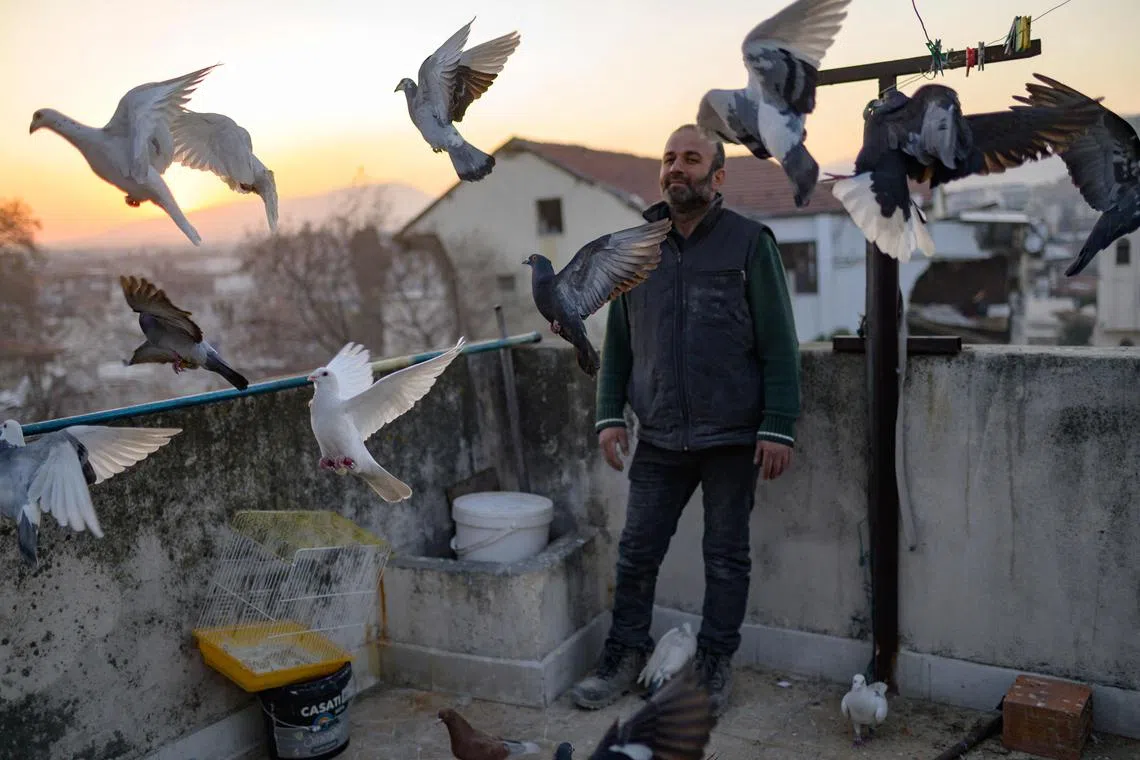Bird man in Turkey vows to tend to flock after quake
Sign up now: Get ST's newsletters delivered to your inbox

Mr Murat Guzel on the roof of a restaurant where he worked at before the earthquake, in Antakya, on Feb 17.
PHOTO: AFP
Follow topic:
ANTAKYA, Turkey – Mr Murat Guzel scatters bird feed on the roof as the sun sets over the Antakya restaurant he used to work at before the earthquake destroyed the southern Turkish city.
Birds, mostly pigeons, some motley and scruffy, others pristine and plump, scrabble for the feed as Mr Guzel, 40, calls to them.
“We take care of our birds the way we take care of our children – and will continue to look after them,” he says.
On the rooftop above Antakya’s old town, he now keeps 40 birds following last week’s 7.8-magnitude quake, having taken 110 back to a village he now calls home.
To reach the birds, Mr Guzel walks through a debris-littered pantry, now covered with jam jars smashed during the tremors, taking a narrow staircase to the rooftop of the traditional Turkish townhouse.
Two large white and brown birds nestle in a dovecote made of wire mesh and wood, while more than 20 others perch on a ledge in anticipation of food.
Before the quake that shattered tracts of south-eastern Turkey and northern Syria and killed more than 43,000 people, Mr Guzel was the cook at the Antakya Breakfast House where guests would eat olives and cheese in the courtyard of the 300-year-old building.
“There are five of us at home, and the five of us came out safe and sound,” he says after they were caught in the quake in Antakya.
He has three children aged nine, 15 and 17, with the youngest inheriting his father’s interest in birds.
“Every morning, we come to our birds and feed them (and) attend to their food, feathers and illnesses,” he says.
The building, which was reinforced with steel girders and escaped with only cosmetic damage, is surrounded by destroyed homes and businesses in the heart of the city’s historical quarter.
Antakya had been a popular tourist destination with visitors from Turkey and abroad.
Nearby orange trees that withstood the shocks stand half-buried in rubble from broken stone walls and twisted wooden door frames.
Mr Guzel gently grips a snow-coloured pigeon he calls “white rose” and explains how healthy wings are vital to the bird’s survival.
Diggers and excavators picking through ruined buildings can be heard nearby.
His father became a bird fancier before he was born but gave up the hobby following Mr Guzel’s arrival.
Pigeon-keeping is a popular hobby in south-eastern Turkey, particularly among the Kurdish community, and pigeon droppings are often used as fertiliser for growing watermelons.
Mr Guzel and his brother gave each other a bird when he was 15 – and have built up their collection since.
“Our love for animals is something else, we like animals as much as humans... maybe more,” he says.
Three or four regular avian visitors have disappeared in the wake of the quake, but have been replaced by 50 more as, he assumes, their keepers are dead.
Initially, Mr Guzel was mostly interested in carrier pigeons. But he now looks after a variety – like humans, “some are very handsome and some are very ugly”.
Mr Guzel, who has a salt and pepper beard and wears a body warmer and jumper, says his birds help to reduce stress when he sits with them.
Sometimes, he sells specimens with special features but they occasionally come back.
Mr Guzel points out one brown and white bird he calls a “foreigner” – not one of his own.
Despite now living in the relative safety of a nearby village, he vows to return daily to care for his regulars and visitors alike.
“As long as they are here, I will be,” he says. AFP

